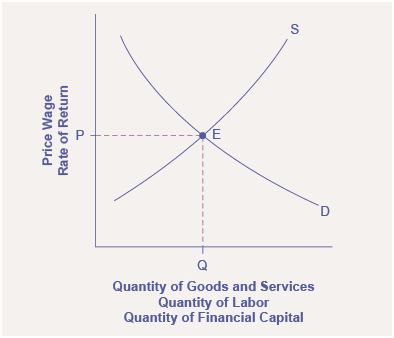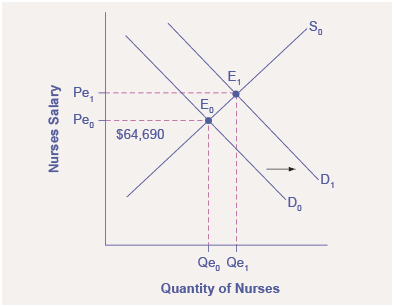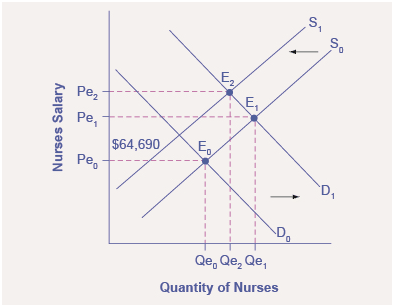信号价格
Section outline
-
Prices as Signals
::信号价格Prices serve as a signal to both consumers and producers. Prices can assist consumers to decide if they have the desire, ability, and willingness to go through with the purchase (demand), and it helps the producer decide what to produce, how to produce, and for whom to produce. The relationship for the consumer is an inverse one: when prices are high consumers buy less, and when prices are low consumers buy more. The same cannot be said for producers. When prices are high they will bring more to the market, and when prices are low they will bring less to the market. As a result, prices serve as a way for both consumers and producers to determine whether or not they want to buy (demand) or sell (supply/produce) a particular good or service.
::价格是消费者和生产者的信号。 价格可以帮助消费者决定他们是否愿意、有能力和愿意进行购买(需求),它可以帮助生产者决定生产什么产品、如何生产和为谁生产。 消费者之间的关系是相反的:当价格是高消费者买少,价格是低消费者买多时,价格是低消费者买多的时候。 生产者不能这样说。 当价格高的时候,价格会给市场带来更多好处,而价格低会给市场带来更少好处。 结果,价格成为消费者和生产者决定他们是否想购买(需求)或出售(供应/生产)某种商品或服务的一种方式。Universal Generalizations
::普遍化-
Prices are important in a free market economy.
::价格在自由市场经济中很重要。 -
Competitive markets use prices as signals.
::竞争性市场利用价格作为信号。 -
Prices communicate information and provide incentives to both producers and consumers.
::价格传达信息并向生产者和消费者提供奖励。
Guiding Questions
::问 问 问 问 问 问 问 问 问 问 问 问 问 问 问 问 问 问 问 问 问 问 问 问 问 问 问 问 问 问 问 问 问 问 问 问 问 问 问 问 问 问 问 问 问 问 问 问 问 问 问 问 问 问 问 问 问 问 问 问 问 问 问 问 问 问 问 问 问 问 问 问 问 问 问 问 问 问 问 问 问 问 问 问 问 问 问 问 问 问 问 问 问 问 问 问 问 问-
How do prices act as a signal in a free market economy?
::在自由市场经济中,价格如何充当信号? -
How can resources be allocated without prices?
::如何在没有价格的情况下分配资源? -
What is the advantage of prices to allocate scarce resources?
::价格对分配稀缺资源有什么好处?
The Market System as an Efficient Mechanism for Information
::市场系统作为高效率的信息机制Prices exist in markets for goods and services, for labor, and for financial capital. In all of these markets, prices serve as a remarkable social mechanism for collecting, combining, and transmitting information that is relevant to the market—namely, the relationship between demand and supply—and then serving as messengers to convey that information to buyers and sellers. In a market-oriented economy, no government agency or guiding intelligence oversees the set of responses and interconnections that result from a change in price. Instead, each consumer reacts according to that person’s preferences and budget set, and each profit-seeking producer reacts to the impact on its expected profits.
::商品和服务市场、劳动力和金融资本市场都存在价格。 在所有这些市场中,价格是收集、合并和传递与市场有关的信息的显著社会机制 — — 即供求关系 — — 然后充当向买卖双方传递这些信息的送信人。 在面向市场经济的经济体中,没有任何政府机构或指导情报机构监督由价格变化产生的一系列反应和互联。 相反,每个消费者都根据个人的偏好和预算组合作出反应,每个追求利润的生产者都对其预期利润的影响做出反应。Why are demand and supply curves important?
::为什么供需曲线很重要?The demand and supply model is the second fundamental diagram for this course. Just as it would be foolish to try to learn the arithmetic of long division by memorizing every possible combination of numbers that can be divided by each other, it would be foolish to try to memorize every specific example of demand and supply in this chapter, this textbook, or this course. Demand and supply is not primarily a list of examples; it is a model to analyze prices and quantities. Even though demand and supply diagrams have many labels, they are fundamentally the same in their logic. Your goal should be to understand the underlying model so you can use it to analyze any market.
::供求模式是本课程的第二个基本图表。 试图通过记住每一个可以相互分割的数字组合来学习长期分裂的算术,这既愚蠢又愚蠢。 试图记住本章、本教科书或本课程中供求的每一个具体例子,也是愚蠢。 供求主要不是一个示例清单;它是一个分析价格和数量的模型。 尽管供需图表有许多标签,但基本上在逻辑上是一样的。 您的目标应该是理解基本模型,以便您能够利用它分析任何市场。[ 1] displays a generic demand and supply curve. The horizontal axis shows the different measures of quantity: a quantity of a good or service, or a quantity of labor for a given job, or a quantity of financial capital. The vertical axis shows a measure of price: the price of a good or service, the wage in the labor market, or the rate of return (like the interest rate) in the financial market.
::[1] 显示通用供求曲线。横向轴显示不同的数量量度:一个或一个或一个或一个或一个工作的数量,或一个或一个工作的数量,或一个金融资本的数量。垂直轴显示一个价格量度:一个或一个服务的价格,劳动力市场的工资,或金融市场的回报率(如利率 ) 。The demand and supply model can explain the existing levels of prices, wages, and rates of return. To carry out such an analysis, think about the quantity that will be demanded at each price and the quantity that will be supplied at each price—that is, think about the shape of the demand and supply curves—and how these forces will combine to produce equilibrium.
::供求模式可以解释现有的价格、工资和回报率水平。 为了进行这样的分析,考虑每种价格要求的数量和每种价格供应的数量 — — 即需求和供应曲线的形状 — — 以及这些力量将如何结合以产生平衡。Demand and supply can also be used to explain how economic events will cause changes in prices, wages, and rates of return. There are only four possibilities: the change in any single event may cause the demand curve to shift right or to shift left; or it may cause the supply curve to shift right or to shift left. The key to analyzing the effect of an economic event on equilibrium prices and quantities is to determine which of these four possibilities occurred. The way to do this correctly is to think back to the list of factors that shift the demand and supply curves. Note that if more than one variable is changing at the same time, the overall impact will depend on the degree of the shifts; when there are multiple variables, economists isolate each change and analyze it independently.
::需求和供应也可以用来解释经济事件将如何导致价格、工资和回报率的变化。只有四种可能性:任何单一事件的变化都可能导致需求曲线向右或向左移动;或可能导致供应曲线向右或向左移动。分析经济事件对平衡价格和数量的影响的关键是确定这四种可能性中的哪一种发生。这样做正确的方式是回想一下改变需求和供应曲线的因素清单。请注意,如果一个以上的变量同时变化,总的影响将取决于变化的程度;如果存在多种变量,经济学家会孤立每一种变化并独立分析。Demand and Supply Curves
::供需曲线The figure displays a generic demand and supply curve. The horizontal axis shows the different measures of quantity: a quantity of a good or service, a quantity of labor for a given job, or a quantity of financial capital. The vertical axis shows a measure of price: the price of a good or service, the wage in the labor market, or the rate of return (like the interest rate) in the financial market. The demand and supply curves can be used to explain how economic events will cause changes in prices, wages, and rates of return.
::数字显示了通用的供求曲线。 水平轴显示了不同的数量量度:货物数量或服务量、特定工作劳动力数量或金融资本数量。 垂直轴显示了一种价格量度:货物价格或服务价格、劳动力市场工资或金融市场收益率(如利率 ) 。 需求和供给曲线可以用来解释经济事件如何导致价格、工资和回报率的变化。An increase in the price of some product signals consumers that there is a shortage and the product should perhaps be economized on. For example, if you are thinking about taking a plane trip to Hawaii, but the ticket turns out to be expensive during the week you intend to go, you might consider other weeks when the ticket might be cheaper. The price could be high because you were planning to travel during a holiday when demand for traveling is high. Alternatively, maybe the cost of an input like jet fuel increased or the airline has raised the price temporarily to see how many people are willing to pay it. Perhaps all of these factors are present at the same time. You do not need to analyze the market and break down the price change into its underlying factors. You just have to look at the price of a ticket and decide whether and when to fly.
::某些产品价格的上涨会给消费者带来短缺,产品或许应该节约。例如,如果你想去夏威夷旅行,但票价在您打算去的一周内很昂贵,你可能会考虑其他星期的票价可能更便宜。价格可能很高,因为你计划在旅行需求高的假期内旅行。或者,喷气燃料等投入的成本会增加,或者航空公司暂时提高了价格,看有多少人愿意支付。也许所有这些因素都同时存在。你不需要分析市场,把价格变化打破到其基本因素。你只要看看机票的价格,决定是否飞和何时飞就可以了。In the same way, price changes provide useful information to producers. Imagine the situation of a farmer who grows oats and learns that the price of oats has risen. The higher price could be due to an increase in demand caused by a new scientific study proclaiming that eating oats is especially healthful. Perhaps instead, the higher price has resulted from the price of a substitute grain, like corn, rising, and people have responded by buying more oats. Whichever factor caused the rise in price, the oat farmer does not need to know the details. The farmer only needs to know that the price of oats has risen and that it will be profitable to expand production as a result.
::同样,价格变化也为生产者提供了有用的信息。 想象一下种植燕麦并了解到燕麦价格已经上涨的农民的状况。 价格上涨可能是由于一项新的科学研究导致需求增加,该研究宣称食用燕麦特别健康。 也许相反,价格上涨是由于替代谷物(如玉米)的价格上涨,人们通过购买更多的燕麦做出回应。 无论哪种因素导致价格上涨,燕麦农民都不需要知道细节。 农民只需要知道燕麦价格已经上涨,因此扩大产量将有利可图。The actions of individual consumers and producers as they react to prices overlap and interlock in markets for goods, labor, and financial capital. A change in any single market is transmitted through these multiple interconnections to other markets. The vision of the role of flexible prices helping markets to reach equilibrium and linking different markets together helps to explain why price controls can be so counterproductive. Price controls are government laws that serve to regulate prices rather than allowing the various markets to determine prices. There is an old proverb: “Don’t kill the messenger.” In ancient times, messengers carried information between distant cities and kingdoms. When they brought bad news, there was an emotional impulse to kill the messenger. This did not solve the problem, however, because killing the messenger did not kill the bad news. Instead , killing the messenger had an undesirable side effect: other messengers would refuse to bring news to that city or kingdom, depriving its citizens of vital information.
::消费者和生产者个人在对价格重叠和商品、劳动力和金融资本市场相互交错作出反应时的行为。 任何单一市场的变化都通过这些多重互联关系传递到其他市场。 灵活价格的作用的愿景有助于市场达到平衡和将不同市场连接在一起,这有助于解释为什么价格管制会产生如此适得其反的效果。 价格管制是政府法律,用来调节价格,而不是允许各种市场决定价格。 有一种古老的谚语 : “ 不要杀死信使 ” 。 在古代,信使们在遥远的城市和王国之间传递信息。 当他们带来坏消息时,有一种情感冲动要杀死信使。 但是,这并没有解决问题,因为杀死信使并没有杀死坏消息。 相反,杀死信使具有不可取的一面效应:其他信使会拒绝向该城市或王国传递新闻,剥夺其公民的重要信息。Those who seek price controls are trying to kill the messenger—or at least to stifle an unwelcome message that prices are bringing about the equilibrium level of price and quantity. However, price controls do nothing to affect the underlying forces of demand and supply, and this can have serious repercussions. During China’s “Great Leap Forward” in the late 1950s, food prices were kept artificially low, with the result that 30 to 40 million people died of starvation because the low prices depressed farm production. Changes in demand and supply will continue to reveal themselves through consumers’ and producers’ behavior. Immobilizing the price messenger through price controls will deprive everyone in the economy of critical information. Without this information, it becomes difficult for everyone—buyers and sellers alike—to react in a flexible and appropriate manner as changes occur throughout the economy.
::寻求价格控制的人试图杀死送信人 — — 或者至少扼杀价格正在带来价格和数量平衡的不受欢迎的信息。 但是,价格控制丝毫不影响供求的基本力量,而这可能产生严重影响。 在中国1950年代末的“大跃跃”期间,食品价格人为地保持低位,导致3000万至4000万人因为低价压低农业生产而死于饥饿。 供需变化将继续通过消费者和生产者的行为显现出来。 通过价格控制使价格传递者失去关键信息将剥夺经济中的每一个人。 没有这一信息,每个人 — — 无论是买方还是卖方 — — 都很难在经济中发生变化时以灵活和适当的方式作出反应。Baby Boomers Come of Age
::婴儿潮婴儿到年龄The theory of supply and demand can explain what happens in the labor markets and suggests that the demand for nurses will increase as healthcare needs of baby boomers increase, as [ 2] shows. The impact of that increase will result in an average salary higher than the $64,690 earned in 2010 referenced in the first part of this case. The new equilibrium (E 1 ) will be at the new equilibrium price (Pe 1 ). Equilibrium quantity will also increase from Qe 0 to Qe 1 .
::供求理论可以解释劳动力市场发生的情况,并表明对护士的需求将随着婴儿潮的保健需求增加而增加,如[2]所示,这一增长的影响将导致平均工资高于本案例第一部分提到的2010年64 690美元,新的平衡(E1)将以新的平衡价格(PE1)为单位,平衡数量也将从Qe0增加到Qe1。Impact of Increasing Demand for Nurses 2010-2020
::2010-2020年护士需求增加的影响In 2010, the median salary for nurses was $64,690. As demand for services increases, the demand curve shifts to the right (from D 0 to D 1 ) and the equilibrium quantity of nurses increases from Qe 0 to Qe 1 . The equilibrium salary increases from Pe 0 to Pe 1 .
::2010年,护士的中位工资为64 690美元,随着对服务需求的增加,需求曲线向右转移(从D0转向D1),护士的均衡数量从Qe0上升到Qe1,平衡工资从Pe0提高到Pe1。Suppose that as the demand for nurses increases, the supply shrinks due to an increasing number of nurses entering retirement and increases in the tuition of nursing degrees. The impact of a decreasing supply of nurses is captured by the leftward shift of the supply curve in [ 3]. The shifts in the two curves result in higher salaries for nurses, but the overall impact in the quantity of nurses is uncertain, as it depends on the relative shifts of supply and demand.
::假设随着对护士的需求增加,由于越来越多的护士退休和护理学位的学费增加,供应量萎缩。 护士供应量下降的影响被[3] 供应曲线左向转移所掩盖。 两个曲线的变化导致护士工资增加,但护士数量的总体影响不确定,因为它取决于供求的相对变化。Impact of Decreasing Supply of Nurses between 2010 and 2020
::2010年至2020年护士供应减少的影响Initially, salaries increase as demand for nursing increases to Pe 1 . When demand increases, so too do the equilibrium quantity, from Qe 0 to Qe 1 . The decrease in the supply of nurses due to nurses retiring from the workforce and fewer nursing graduates ( ceterus paribus ), causes a leftward shift of the supply curve resulting in even higher salaries for nurses, at Pe 2 , but an uncertain outcome for the equilibrium quantity of nurses, which in this representation is less than Qe 1 , but more than the initial Qe 0 .
::最初,由于对护理的需求增加,工资增加到Pe1。 当需求增加时,平衡数量也随之增加,从Qe0到Qe1。 由于护士从劳动力队伍退休和护理毕业生人数减少,护士供应量减少,导致供应曲线向左转移,导致护士在Pe2的工资甚至更高,但护士的平衡数量却有不确定的结果,而这一比例低于Qe1,但高于最初的 " Qe0 " 。While we do not know if the number of nurses will increase or decrease relative to their initial employment, we know they will have higher salaries. The situation of the labor market for nurses described in the beginning of the chapter is different from this example, because instead of a shrinking supply, we had the supply growing at a lower rate than the growth in demand. Since both curves were shifting to the right, we would have an unequivocal increase in the quantity of nurses. Because the shift in the demand curve was larger than the one in the supply, we would expect higher wages as a result.
::虽然我们不知道护士人数与最初就业相比会增加还是减少,但我们知道他们的工资会更高。 本章开头所描述的护士劳动力市场的情况与这个例子不同,因为供应没有减少,供应增长的速度比需求增长要低。 由于这两个曲线都向右移动,我们就会明确增加护士的数量。 由于需求曲线的变化大于供应曲线,我们期望因此提高工资。The market price system provides a highly efficient mechanism for disseminating information about relative scarcities of goods, services, labor, and financial capital. Market participants do not need to know why prices have changed, only that the changes require them to revisit previous decisions they made about supply and demand. Price controls hide information about the true scarcity of products and thereby cause misallocation of resources.
::市场价格体系为传播有关货物、服务、劳动力和金融资本相对稀缺的信息提供了一个高效的机制。 市场参与者不需要知道价格为何发生变化,而只是这些变化要求他们重新审视以前就供求问题做出的决定。 价格控制掩盖了产品真正稀缺的信息,从而导致资源分配不当。For additional information on the topic of prices as signals, read the following articles:
::将 " 价格作为信号 " 专题的补充资料改为 " 下列条款 " :Video: Shifting Demand and Supply
::视频:改变需求与供应To review how various factors cause supply and demand curves to shift, view the following video.
::为了审查各种因素如何导致供求曲线的转变,请观看以下录像。Answer the self check questions below to monitor your understanding of the concepts in this section.
::回答下面的自我核对问题,以监测你对本节概念的理解。Self Check Questions
::自查问题1. Define price.
::1. 确定价格。2. What are the advantages of prices?
::2. 价格有什么好处?3. How can prices be a signal to consumers? To producers?
::3. 价格如何能向消费者发出信号?向生产者发出信号?4. What would happen if there were no prices? How could products be distributed?
::4. 如果没有价格,会发生什么情况?如何分配产品?5. Besides being a signal for consumers and producers, what else can prices determine?
::5. 除了向消费者和生产者发出信号外,价格还能决定什么? -
Prices are important in a free market economy.



